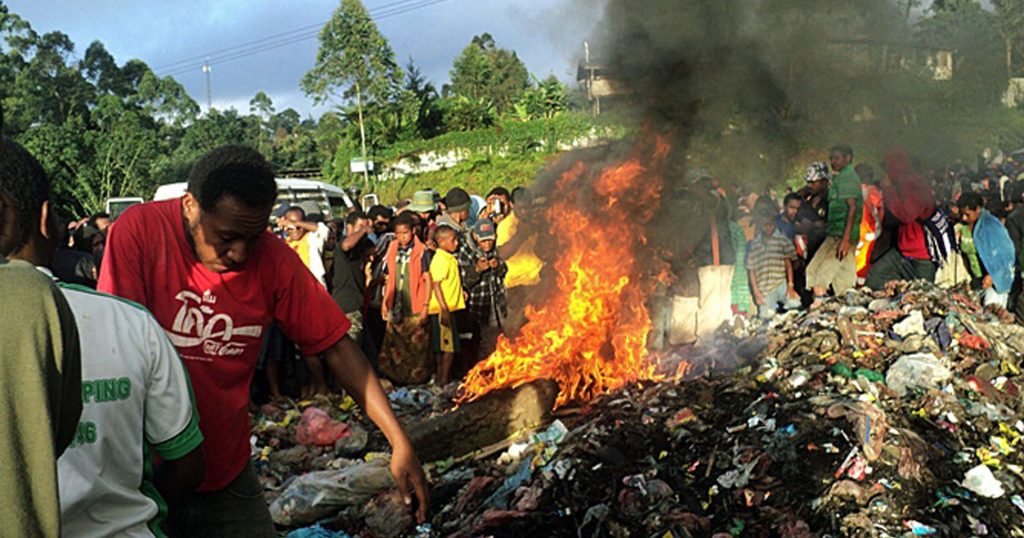Brutal witch-hunts and lynchings have plunged parts of Papua New Guinea’s highlands into a state of terror, as fearful tribes blame dark forces for their rapidly changing world.
Mother-of-two Rachel showed the scars from wounds inflicted on her in April 2017 when she was accused of sorcery and witchcraft and tortured with hot machetes, spades and rods in Paua New Guinea.
In one particularly horrifying incident, an elderly woman writhed and pleaded hysterically as she was mercilessly beaten, raped and tortured on a hut floor, before her naked body – bloodied and nearly lifeless- was dragged outside, where a village mob beat and burned her.
Almost everyone joins in. No one bothers to obscure their face. No one tries to stop it. The crowd believe what they are doing is right: the only way to stop a non-human sorcerer who has killed their clansman and devoured his heart.
The graphic scene was captured by cell phone video that was obtained by AFP. Dozens of similar videos have been gathered as evidence by the Royal Papua New Guinea Constabulary showing the brutal reality of modern-day witch-hunts.
There have been at least 20 murders linked to sorcery accusations in this part of the highlands in the past few years, and dozens more violent attacks.
In places like the remote Tsak Valley, attacks have spread “like bushfire”, said Senior Inspector Epenes Nili, even resulting in an attack on the country’s then chief justice.
Belief in sorcery and witchcraft has long been common across Enga province and Papua New Guinea, but these lynchings are not some ancient rite or custom.
“This is a new phenomenon,” insisted Anton Lutz, a Lutheran missionary who has spent his life in Enga Province and has rescued accused sorcerers, some as young as six.
Other researchers say widespread lynchings are new in Enga, and the extreme brutality and sexual nature of the attacks is unheard of. “We did have ancient beliefs about ghosts and ancient beliefs about stones that could talk and all kinds of interesting things,” Lutz said.
“But this practice of accusing a woman of causing death and torturing her sadistically and sexually for hours until she dies is a new thing. It began about five years ago,” he said.
“We had a serious rise last year. It just seemed like there was an attack happening every week, every fortnight.”
According to Lutz, each spasm of violence seemed to begin with a death that locals found difficult to explain. Heart attacks, diabetes and HIV/AIDS are becoming more common, but are still not well understood.
The death of an otherwise healthy person was more easily blamed on sorcery than cholesterol. Even a recent drunk driving crash that killed eight people prompted a violent witch-hunt, as people tried to explain why some passengers survived and others did not.
The sheer number of people involved in the mob attacks ensures that news spreads quickly, as does fear, due to the widespread belief that witches don’t act alone. The emergence of “Glasman” — opportunist “diviners” who travel the countryside detecting witches for money — also exponentially increased the rate of killings. So too did tribally ordained retribution.
Like the old woman in the video, 55-year-old mother-of-two Rachel, was accused of “sanguma” — sorcery. Her story shows how quickly suspicion can turn into violence.
Her life changed suddenly in April 2017, when she went with her family to pay her respects at a funeral service for a member of a neighbouring tribe.
She was getting ready to leave, looking for her children, when she was grabbed by the dead man’s son. Unknown to Rachel, another woman had been accused of involvement in his death and under torture named Rachel as part of a coven.
Rachel pleaded innocence. But she was stripped and, like the murdered woman in the video, violated and burned with hot machetes, spades and rods for a full day by people she knew who were trying to make her “return the heart” of her “victim.”
“The pain was beyond endurance,” she recalled, speaking to AFP as a crowd of locals — some curious, others appearing suspicious — gathered near her hut. “I thought I would die.”
With her mouth gagged, and the pain too much to bear, she managed only a silent prayer: “You gave me the job of caring for my children, but if I die, who will care for them?”
Only a dispute among the mob, estimated at around a thousand people, saved her life.
Across Papua New Guinea the specifics of witch-hunts are bafflingly different. In Enga, the victims of violence are almost exclusively women.
But on Bougainville island they are almost always men. In Port Moresby, where violence linked to sorcery accusations has also increased, men and women are targeted.
Researcher Miranda Forsyth at the Australian National University, who has studied hundreds of such cases, sees grim patterns emerging.
She describes a “script” of violent responses to suspected sorcerers that is spreading across Enga. Part of the phenomenon is people trying to deal with “high levels of uncertainty due to dramatic economic, social and cultural changes”, Forsyth said.
In the meantime, fear has “turned the whole place into a paranoid mess”, said Lutz. Almost two years after Rachel’s attack, she can walk again and has returned to her village, although even among her own people, she still lives in fear.
“The situation is still tense,” she said in a near whisper. The burns she sustained in the attack had only partially been treated when a mob came to the clinic where she was recuperating, forcing her to flee.
She still complains of skin being tight and painful around her torso. “Even though I still need surgery, I am afraid my attackers might kill me if I go. So I live with the pain.” “I hope that things will calm down so that I can go to the hospital, but for now, the way is closed.
(Vanguard)

